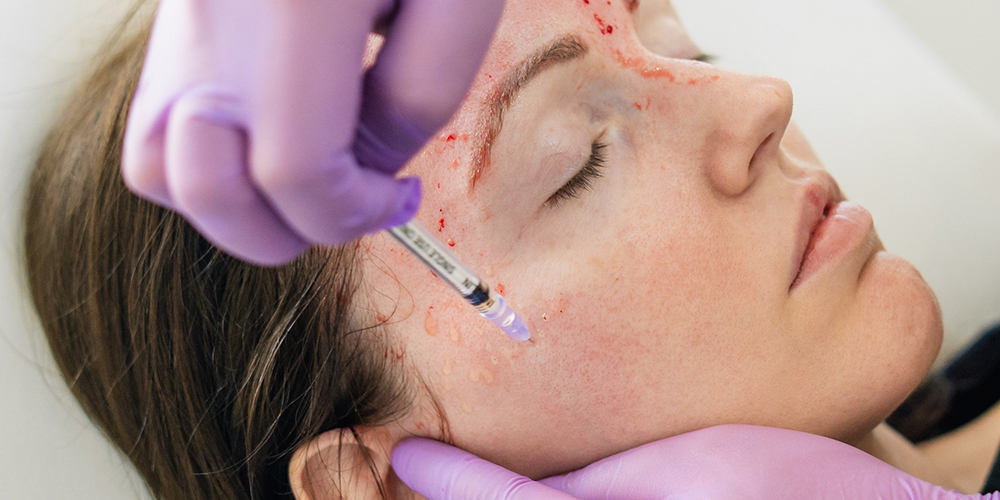- +91 97727 60561
- info@drdhabhai.in
- Wed - Sat: 5 PM - 8 PM Sunday Off

The ‘Vampire Facial,’ also known as the Platelet-Rich Plasma (PRP) facial, gained widespread attention recently for its supposed rejuvenating effects on the skin. This cosmetic procedure involves extracting the patient’s blood, processing it to concentrate platelet-rich plasma, and then re-injecting it into the face to promote collagen production and skin revitalization. While the ‘Vampire Facial’ has been embraced by some as a revolutionary anti-ageing treatment, it has also faced controversy and scepticism in the medical community. In this comprehensive article, we will explore the science behind the ‘Vampire Facial,’ examine the claims made by proponents and sceptics, and delve into this unique cosmetic procedure’s potential risks and benefits.
The concept of using platelet-rich plasma for medical purposes dates back to the 1970s when it was used to facilitate wound healing and bone regeneration. PRP contains a higher concentration of platelets, growth factors, and cytokines, which are believed to play a crucial role in tissue repair and regeneration. In the ‘Vampire Facial,’ the PRP is extracted from the patient’s blood using a centrifuge, resulting in a highly concentrated solution that is then introduced back into the facial skin through microneedling or injection.
Advocates of the ‘Vampire Facial’ claim that the PRP stimulates collagen production, increases blood flow, and promotes tissue rejuvenation. As a result, the skin may appear more youthful, with improved texture and reduced wrinkles. However, the scientific evidence supporting these claims remains limited, and the procedure’s efficacy has been debated.
The ‘Vampire Facial’ gained notoriety when Kim Kardashian, a prominent celebrity, shared her experience with the procedure on social media in 2013. The buzz generated by her endorsement catapulted the PRP facial into the spotlight, leading to an influx of interest from the general public and the cosmetic industry. Numerous spas, clinics, and aesthetic centres began offering the ‘Vampire Facial’ as part of their service menu, often at a premium price due to its celebrity association.
Proponents of the ‘Vampire Facial’ praised its non-invasive nature compared to surgical facelifts and its potential for delivering natural-looking results. Some patients reported positive outcomes, claiming their skin appeared more radiant and youthful following the procedure.
Despite the increasing popularity of the ‘Vampire Facial,’ medical professionals and regulatory bodies have remained cautious about endorsing the procedure without more substantial scientific evidence. Critics argue that the current research supporting PRP’s efficacy for skin rejuvenation is preliminary and lacks large-scale, controlled studies.
Moreover, concerns have been raised about the procedure’s safety when performed by untrained or inexperienced practitioners. Like any medical intervention, there are potential risks associated with the ‘Vampire Facial,’ including infection, bruising, and allergic reactions. Additionally, some experts worry about the potential for adverse reactions or complications when PRP is introduced into sensitive facial tissues.
With the increasing demand for the ‘Vampire Facial,’ there have been calls for better regulation and standardization of the procedure. Medical authorities emphasize ensuring that only licensed and qualified practitioners perform the treatment. Guidelines on proper PRP preparation, administration, and patient selection should be established to minimize the risk of adverse events and optimize outcomes.
It is also crucial to provide patients with realistic expectations regarding the results of the ‘Vampire Facial.’ As with any cosmetic procedure, individual responses can vary, and the extent of improvement may differ among patients.
The media’s portrayal of the ‘Vampire Facial’ has significantly shaped public perceptions of the procedure. Celebrity endorsements and viral stories have often overshadowed medical opinions, leading to misinformation and misconceptions among the public.
While the media has the power to educate and inform, it is also responsible for presenting a balanced view of medical procedures. The ‘Vampire Facial’ phenomenon highlights the need for responsible reporting and for individuals to seek reliable information from medical experts before considering any cosmetic intervention.
The ‘Vampire Facial’ remains a subject of fascination and controversy in the cosmetic industry. While proponents praise its potential for skin rejuvenation and natural-looking results, the medical community seeks more robust scientific evidence to support these claims. As with any cosmetic procedure, patients considering the ‘Vampire Facial’ should carefully weigh the potential risks and benefits and consult with qualified medical professionals. Making informed decisions based on accurate information and prioritizing safety and efficacy above media hype and celebrity endorsements is essential. The ongoing debate surrounding the ‘Vampire Facial’ underscores the importance of balancing innovation, safety, and ethical medical practice in cosmetic procedures.